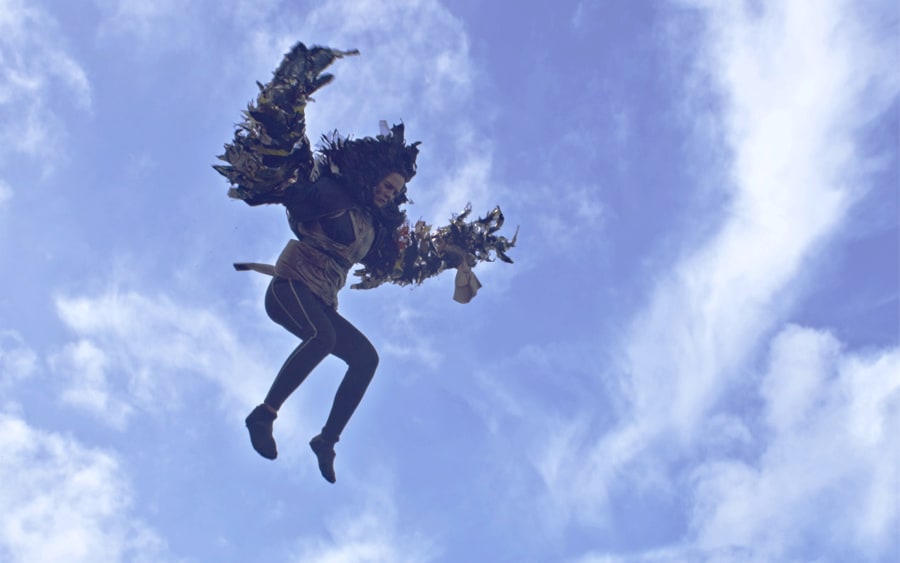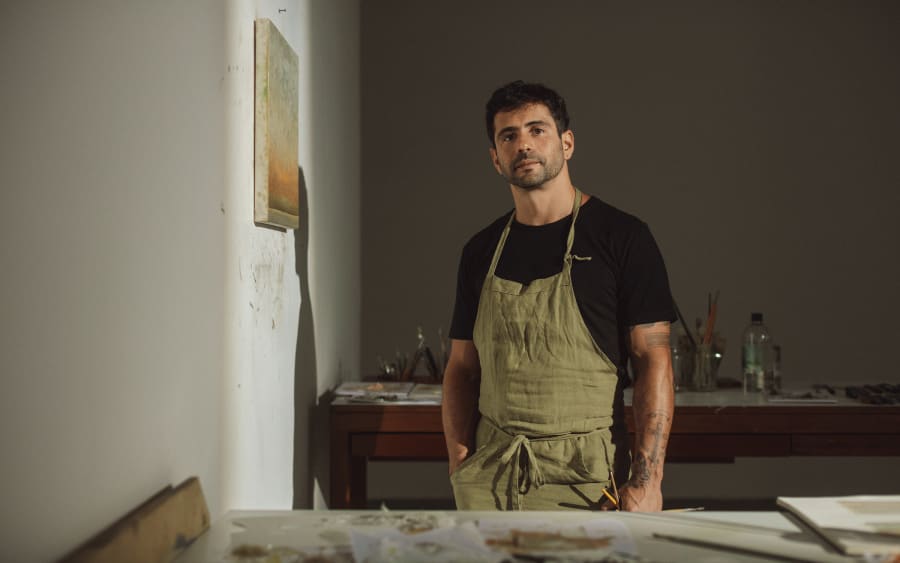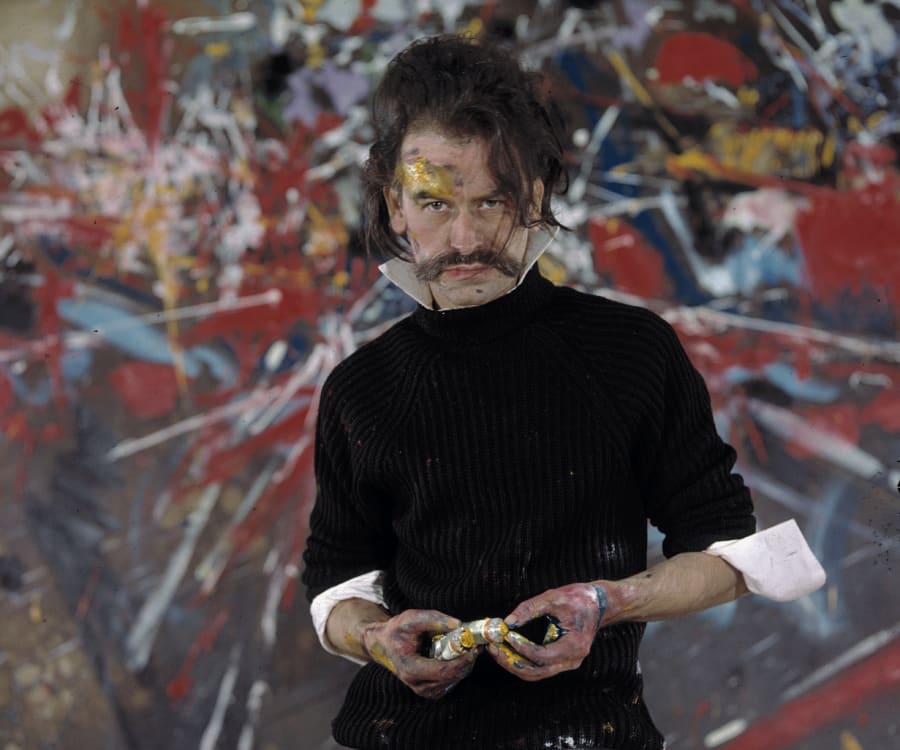Last August, by the fountain in London’s Piccadilly Circus, two large, bright orange structures were erected, both displaying encouraging messages in capital yellow letters: ‘DREAM WITH LOVE’ and ‘KEEP YOUR DREAMS CLOSE.’ Above these grand pedestals created by Yinka Ilori stood white silhouettes of mythology’s most famous flying horse, Pegasus, now in dialogue with the statue of Eros, the Greek god of love, perched atop the site’s historic fountain.
By transforming the spirited winged creature into an allegory for freedom and the power of imagination, the British artist proved through this public work something that has long been evident: Greco-Roman mythology, with its abundance of imperfect characters, fantastic creatures, and dramatic scenarios, remains an inexhaustible source of inspiration for artists today.
‘Greek myths speak of love, death, the reversal of fate, grief, hatred, revenge, thirst for power, desire. They touch the essence of human experience,’ explains Aphrodite Gonou, who oversees the contemporary art program at Athens’ Museum of Cycladic Art, which regularly invites artists – including Marlene Dumas, Brice Marden, and Paul Chan – to create projects in dialogue with its ancient treasures. ‘We feel the same sufferings, the same grief across epochs. We struggle for power, we identify with those who have lost it or never had it and with their quest for justice.’
From the Venus de Milo to Caravaggio’s Bacchus, ancient gods and heroes have prompted countless masterpieces in Western art history. They have continuously traversed movements and eras, generating iconographies that some now seek to deconstruct. Take the young Czech painter and sculptor Vojtěch Kovařík, who presents these tutelary figures as giant characters, occupying nearly the entirety of works where they now appear confined and vulnerable. ‘Myths help us see that life cycles repeat themselves in different forms, and even offer us a certain catharsis,’ the thirtysomething artist asserts.
Presented in the Tuileries Garden, Paris, in 2023, his ochre concrete sculpture of Ares shows the implacable god of war in an unusual posture – seated, melancholic, his weapon on the ground. We witness here not only the fall of the hero but also of supreme masculinity, which the artist continues to interrogate in his depictions of the gods? Prometheus and Hermes.
The same applies to the darkest characters of Greco-Roman myths, such as Medusa, a figure with serpent hair and eyes capable of turning to stone any who gazed upon her. A symbol of female rage considered deadly for centuries, the monster has undergone a rehabilitation, traced in part by the exhibition dedicated to her at the Caen Fine Arts Museum in 2023. In the 21st-century, artists haven’t hesitated to slip into the skin of the frightening Gorgon to reveal her humanity, like Dominique Gonzalez-Foerster and Laetitia Ky.
A young Ivorian photographer, the latter has even made Medusa an emblem of the post-#MeToo feminist struggle, citing one version of the myth in which the goddess Athena, jealous, gave Medusa her repulsive appearance after learning that Poseidon had raped her. ‘A good metaphor for how the world still punishes rape victims rather than rapists,’ the artist posted on her Instagram account as a caption for her Self-Portrait as Medusa (2022). For this image, her own hair had been sculpted into serpents.
A similar phenomenon seems to be occurring with the myth of the Minotaur, the famous man with a bull’s head imprisoned at the center of a labyrinth from which he could not escape. An incarnation of man’s sexual desire and his bestial becoming, the creature has interested numerous artists of modernity, from Pablo Picasso to the Parisian Surrealists, who even named their famous journal after him.
Since then, the painter Chris Ofili has seized upon the figure to address racist stereotypes that have often stigmatized Black men by comparing them to animals, while the young French artist Quentin Fromont explores its representation to speak of marginal bodies: ‘The Minotaur embodies the fear of the different body, of desire outside the norm, condemned to wander in a labyrinth without exit. His very existence is a reminder of how societies create and exclude their own monsters.’ In the artist's work, the character’s confinement materializes in the photograph of a man with a blurred face, transfer-printed onto an assembly of hundreds of plaster squares, of which he now seems prisoner.
In their joint exhibition presented last year in Budapest, the Hungarian artists Zsófia Keresztes and Zsófia Antalka interpreted the monster as an ‘allegory of female rage and aggression still very often repressed by social norms,’ norms they likened to the Knossos maze. More abstract and symbolic, their feminist reading of the myth was seen particularly in mosaic sculptures resembling cages and bead curtains drawing a leery smile.
The artist Miles Greenberg notes: If Greek mythology remains ever relevant, it’s also because the importance and longevity of its representation in Western art history makes it one of the most widely disseminated, and therefore comprehensible, canons in the world. For several years, the young Canadian has been appropriating these myths in his performances to speak about Black and queer identity. ‘When my body or those of the performance artists with whom I work intervene in these mythologies, something is rewritten,’ he says. ‘I can superimpose my own narratives, invented or lived, onto this structure, taking advantage of our built-in familiarity [with mythology] to introduce something new.’ Begun in 2021, his first series of steel sculptures exclusively cited ‘mythological figures who died from human error or caprice’ – namely Icarus, who falls after flying too close to the sun; Orpheus, who turns to see his lover Eurydice; Narcissus, who falls into water wanting to embrace his reflection… All myths that, like that of the Minotaur, reveal human fallibility, universal and timeless.
Many authors have sought to evoke the breathtaking inventiveness of these myths, but few have succeeded as brilliantly as the Roman poet Ovid. Even today, one often encounters his Metamorphoses – a veritable bible of Greek mythology, but also an essential reference for artists for centuries – in studios. Doubtless because the long poem teems with hybrid creatures similar to those that populate our dreams.
In 2024, the centenary of Surrealism reminded us how much these chimeras nourished the imagination of the movement’s major figures, from André Masson to Leonor Fini. Today, they permeate the practices of artists who consider themselves their heirs, like Marguerite Humeau and Louise Bonnet, ‘new surrealists’ featured in the selection of the 59th Venice Biennale, which is aptly articulated around Leonora Carrington’s essay The Milk of Dreams.
From the nymph Daphne, who transforms into a laurel to escape Apollo, to the goddess Artemis, who turns the hunter Actaeon into a stag for seeing her naked, many myths encourage, through the fusion between human, animal, and plant, a salutary return to nature. Kovařík corroborates: several myths can be reread as incentives to preserve our ecosystem in light of climate crises, such as Deucalion and Pyrrha, which speaks of ‘flooding of the world and a new migration,’ or Phaethon, about ‘ecological imbalance and catastrophe.’
However, beyond the warnings, Greco-Roman myths might, above all, prove reassuring in the eyes of this new generation. ‘Faced with the speed and instability of the world,’ the artist adds, ‘perhaps we are seeking to return to something that never seems to change – the archetypes that have accompanied humanity for centuries.’


